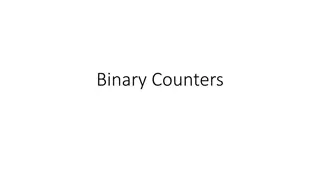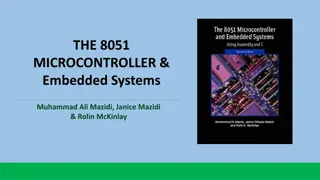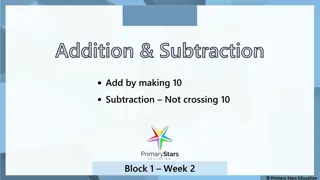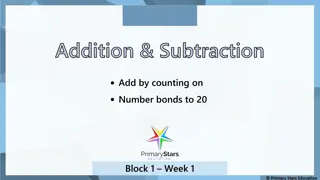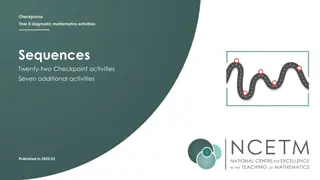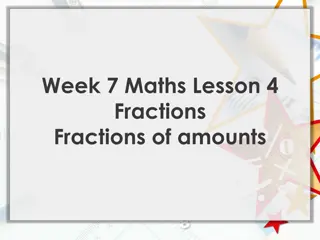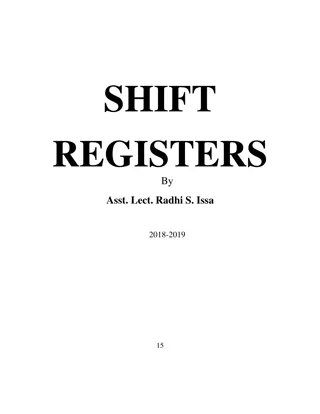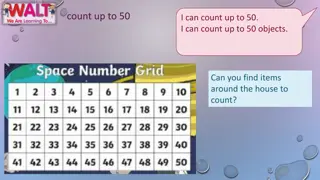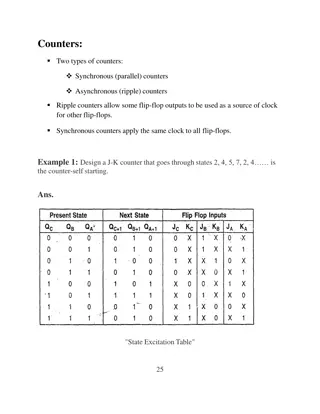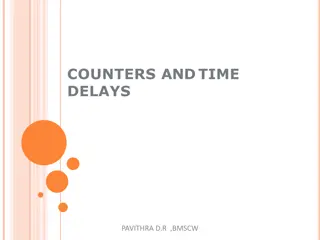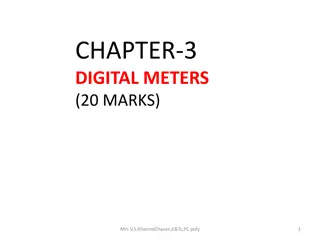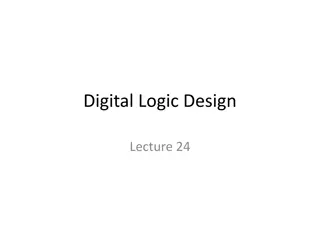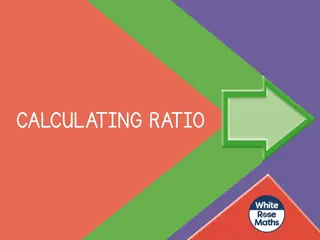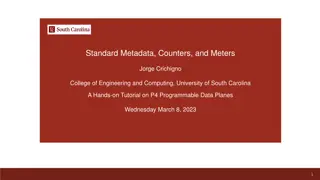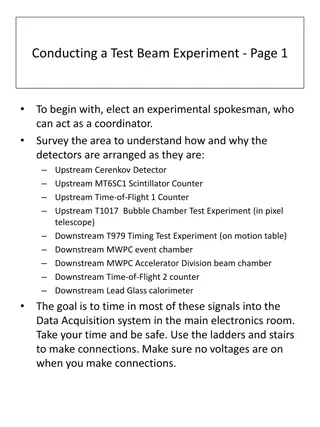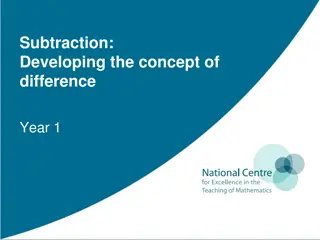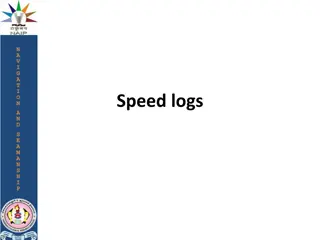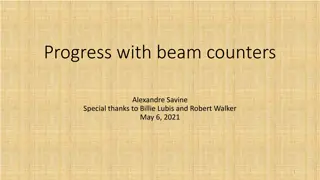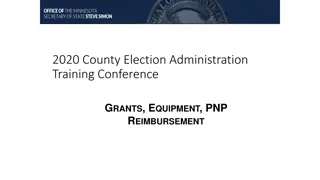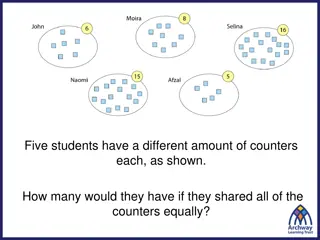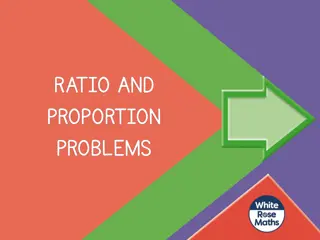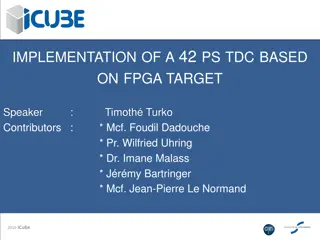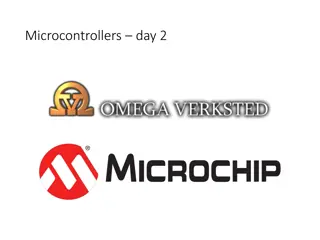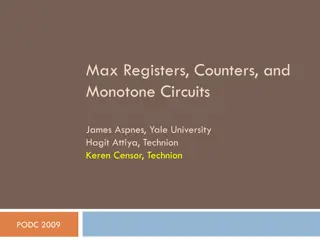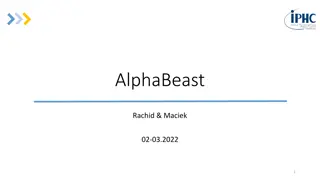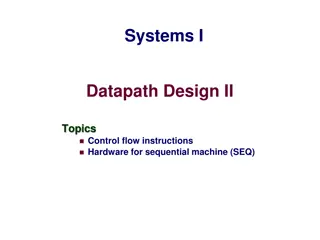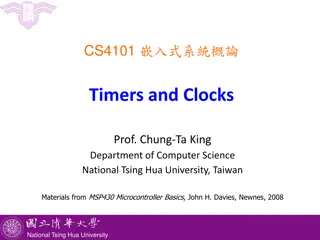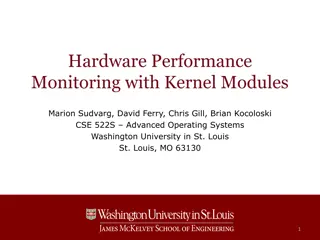ANALOG AND DIGITAL ELECTRONICS 21CS33
Explore the world of analog and digital electronics through the lens of registers, counters, and flip-flops. Dive deep into the operation of these components, learn how to transfer data between registers, build and analyze shift registers, construct timing diagrams, and understand binary counters. D
0 views • 112 slides
Innovative Equipment Management for Improved Blood Testing in India
The LABS.FOR.LIFE.PROJECT in India, a collaboration between MoHFW, CDC, and BD, focuses on enhancing blood testing capabilities. Advanced equipment like Complete Blood Count Analyzers and different types of Cell Counters are used to analyze various blood components. The operation principles, such as
0 views • 19 slides
Understanding Binary Counters and Types of Counters
Binary counters are registers used to count clock pulses, while binary counters follow the binary number sequence. There are two types of counters: serial/asynchronous counters and parallel/synchronous counters. Serial counters change output flip-flop to next flip-flop, requiring minimal hardware bu
12 views • 21 slides
Introduction to 8051 Microcontroller Timer Programming
Explore the world of 8051 microcontroller timer programming through this comprehensive guide. Learn about the timers, their registers, modes, and how to program them in Assembly and C language to generate time delays and event counters. Delve into examples to understand timer selection, clock freque
1 views • 46 slides
What is the Frontier Airlines check-in method?
Frontier Airlines gives a number of check-in options, including self-service kiosks at the airport, traditional check-in desks, and online check-in via their website or mobile app, which is available 24 hours prior to departure. Passengers can receive their boarding passes on their mobile devices or
0 views • 5 slides
Math Subtraction Practice for Kids
Engage children in subtraction practice with these interactive exercises. Students complete number sentences by subtracting from a starting quantity, reinforcing the concept of "crossing 10." The fluency tasks include scenarios with counters and objects of different colors to make learning fun and e
1 views • 12 slides
Maths Addition and Subtraction Lesson with Fluency, Reasoning, and Problem Solving Activities
Engage in a comprehensive maths lesson focusing on addition and subtraction by making ten, avoiding crossing ten. The lesson includes fluency exercises using counters, reasoning tasks based on calculations, and problem-solving scenarios. Dive into various mathematical situations to enhance your skil
1 views • 10 slides
Math Addition and Subtraction Practice for Number Bonds to 20
Dive into a comprehensive lesson plan focusing on addition and subtraction within number bonds to 20. Explore fluency exercises, reasoning tasks, and problem-solving challenges using counters to strengthen mathematical skills. Engage with interactive activities to master fundamental concepts in a fu
0 views • 8 slides
Year 8 Mathematics Checkpoint Activities: Sequences & More
Dive into the diagnostic mathematics activities aimed at Year 8 students, focusing on sequences. The publication includes twenty-two Checkpoint activities with additional exercises, covering topics like adders, counting counters, same jump comparisons, and multiples. Explore the underpinnings of mat
0 views • 51 slides
Understanding Fractions: Week 7 Maths Lesson
Dive into fractions of amounts with engaging activities like matching representations to statements, finding percentages of numbers, using place value counters, and more. Enhance your skills in identifying equal groups, filling in calculations, and reasoning with fractions. Strengthen your math flue
0 views • 19 slides
Shake, Rattle and Roll: Exciting 2-Player Dice Game
Dive into the fun 2-player game of Shake, Rattle, and Roll where players multiply dice rolls to cover answers on the board with counters. The first player to use all their counters wins the game! Get ready for a strategic and engaging gameplay experience. Create your own boards for endless entertain
0 views • 5 slides
Understanding Shift Registers in Digital Electronics
Shift registers are a fundamental concept in digital electronics where binary numbers are shifted from one flip-flop to the next. They come in various types like SISO, SIPO, PISO, and PIPO, serving different purposes such as delay lines, data converters, sequential memory, and ring counters. The ope
0 views • 10 slides
Fun Counting Activities for Kids at Home
Engage your child in interactive counting activities using everyday items found around the house. Practice counting up to 50 objects, listen and count as counters are dropped into a jar, and create whole-part models based on different scores. Keep learning fun and educational with these entertaining
0 views • 4 slides
Understanding Synchronous and Asynchronous Counters in Digital Electronics
Explore the concepts of synchronous (parallel) and asynchronous (ripple) counters in digital electronics, where ripple counters enable clock sharing among flip-flops and synchronous counters apply the same clock to all. Learn to design J-K and up-down counters using flip-flops with examples and stat
1 views • 4 slides
Understanding Arrays and Number Relationships for Learning Math
Explore the concepts of arrays, commutativity, factors, primes, squares, and multiplication strategies for building arrays. Delve into understanding rows, columns, and various ways to calculate products efficiently. Discover how to make arrays using counters and learn about prime numbers and factor
0 views • 10 slides
Understanding Counters in Sequential Circuits
Counters in sequential circuits are crucial components used for counting clock cycles and measuring time intervals. They are composed of flip-flops that progress through a sequence of states based on clock pulses. This sequential circuit has no inputs other than the clock pulse and relies on its int
1 views • 22 slides
Understanding Counters and Time Delays in Electronics
Explore the fundamental concepts of counters and time delays in electronic systems as explained by Pavithra D.R. from BMSCW. Learn about the design and operation of counters, time delay procedures, label states, time delay using register pairs, flowcharts for time delays, and illustrative programmin
5 views • 10 slides
Understanding Sequential Counters in Digital Circuits
Sequential counters, comprised of flip-flops, are essential in digital circuits for counting clock cycles. They advance through states based on clock pulses and can measure time intervals. The circuit's output state solely depends on its present state, with transitions occurring at each clock pulse.
0 views • 22 slides
Understanding Digital Meters in Electronics
Digital meters are essential instruments in electronics for accurate measurement of signals and frequencies. They offer advantages like high accuracy, resolution, and portability compared to traditional analog instruments. Learn about the principles, functionality, and components of digital meters,
0 views • 18 slides
Digital Logic Design Lecture on Registers and Counters
In this lecture, we covered topics on Registers and Counters in digital logic design. Registers are used to hold information within a digital system, while Counters are utilized to produce specified output pattern sequences. Different types of registers such as shift registers were discussed along w
0 views • 25 slides
Ratios in Different Scenarios
Explore and solve various ratio-related problems involving counters, bees, spiders, bread rolls, ladybirds, and spiders. From determining the number of red counters given the ratio to finding out the quantity of bread rolls in multiple baskets based on the provided ratio, these exercises help streng
1 views • 18 slides
Understanding Standard Metadata, Counters, and Meters in P4 Programmable Data Planes
Learn about the role of metadata in packet processing, the significance of intrinsic metadata, and how to utilize custom headers for monitoring switch queues in P4 programmable data planes. This tutorial explores the V1 Model standard metadata and provides hands-on experience in defining and using c
0 views • 21 slides
Conducting a Test Beam Experiment - Step-by-Step Guide
In this step-by-step guide, you will learn how to set up and conduct a test beam experiment. The experiment involves connecting detectors such as Cerenkov Detectors, Scintillator Counters, Bubble Chambers, and more. The process includes handling signal cables, high voltage connections, and checking
1 views • 5 slides
Mastering Portable Exhibition Counters From Setup to Stand Out Success
This presentation offers a detailed guide on mastering portable exhibition counters for trade shows and events. It covers essential topics such as selecting the right counter, effective branding strategies, setting up for success, and engaging visito
1 views • 12 slides
Exploring Subtraction Concepts in Year 1 Math Lesson
Dive into the world of subtraction in a Year 1 math lesson focused on developing the concept of difference. From warm-up activities to representing subtraction with counters, this resource guides you through counting odd and even numbers, understanding take away vs. difference, and extending concept
0 views • 26 slides
Understanding Speed Logs and Their Evolution in Maritime Navigation
Speed logs play a crucial role in measuring a vessel's speed and distance traveled through water. The evolution from primitive chip logs to modern RPM counters has significantly improved accuracy and efficiency in maritime navigation. Learn about the history, types, and working principles of speed l
0 views • 17 slides
Progress with Beam Counters: Alexandre Savine
In this update, progress with beam counters is highlighted, giving special thanks to individuals involved. Details on timing resolution, weighting schemes, iterative procedures, and sample comparisons are discussed. The journey towards optimal filtering and accurate calculations unfolds in the realm
0 views • 12 slides
2020 County Election Administration Training Grants and Equipment Overview
The 2020 County Election Administration Training Conference focuses on grants, equipment, and PNP reimbursements. The VEGA-2 Grants offer funding for optical scan voting equipment, ballot counters, assistive voting devices, and electronic roster equipment. The breakdown of awards shows the allocatio
0 views • 15 slides
Understanding Means and Averages in Mathematics
Learn how to calculate means and averages using real-world examples: sharing counters equally among students, tracking daily vegetable portions, finding the mean of different sets of values, determining missing values in sets, and adjusting sums to meet new mean averages.
0 views • 13 slides
Problem Solving with Ratios and Recipes
This collection of exercises involves solving ratio problems related to red and yellow counters, as well as calculating ingredient quantities for soup recipes based on different serving sizes. Practice your math skills and cooking knowledge with these varied scenarios.
0 views • 21 slides
Implementation of a 42-PS TDC Based on FPGA Target
Context: Time-to-Digital Converter (TDC) architecture, methodology, and realization for high-throughput time-correlated single-photon counting in microfluidic droplets. Fluorescence Lifetime (FL) measurements offer high system sensitivity and accuracy. TDC specification for FPGA target with temporal
0 views • 21 slides
Understanding Microcontroller Interrupts and Applications
Explore the fundamental concepts of interrupts, PWM, timer/counters, and ADC in microcontrollers. Learn how to use interrupts for tasks like LED blinking, control LED brightness with PWM, and read voltage using ADC. Get insights on interrupt routines, enabling interrupts through registers, and tips
0 views • 32 slides
Exploring SEAL Maths in Currie Nursery: A Pedagogical Approach to Early Arithmetical Learning
SEAL Maths, a prominent program in City of Edinburgh, focuses on stages of early arithmetical learning, emphasizing understanding, strategies, and mental agility. The curriculum includes emergent to facile stages with activities like forward/backwards number word sequence, numeral recognition, and a
0 views • 15 slides
Advancements in Counting Algorithms for Multiprocessing Systems
Presentation of key concepts and advancements in counting algorithms for multiprocessing systems, focusing on topics like max registers, counters, and monotone circuits. Discusses the importance of efficient counting in achieving consensus, crash failure requirements, and lower bounds for time compl
0 views • 20 slides
Next Version Development for AlphaRad4 Sensor Front-End
In this project, the goal is to create the next version of the AlphaRad4 sensor front-end system by modifying the AlphaRad3 front-end to work with the sensors from AlphaRad4. The project involves various functional and electrical specifications, including gain ranges, comparators, counters, and diff
0 views • 18 slides
Neutron Radiation Measurement Guidelines and Techniques
Understanding neutron detection basics, absorption cross-section, moderators, positioning, and common detector types is crucial for accurate measurements. Neutrons vary in energy levels, requiring specific detection techniques. Thermal neutrons are easier to detect than fast ones, with materials lik
0 views • 34 slides
Sequential Machine Datapath Control Flow Design
Explore the hardware implementation of control flow instructions for a sequential machine, including executing jumps, calls, and returns. Dive into the stages of computation involved in handling branching, fetching instructions, updating program counters, and managing stack pointers.
0 views • 35 slides
Embedded Systems: Timers, Clocks, and Real-Time Control
Explore the role of timers and clocks in embedded systems, covering topics such as real-time monitoring, time-based control, and challenges with software delay loops. Learn about using hardware counters for time references and integrating timers as I/O devices in clock systems.
0 views • 48 slides
Hardware Performance Monitoring with Kernel Modules
This document explores the use of hardware performance counters and cycle counting on x86 and ARM architectures for monitoring and analyzing system performance. It covers topics such as the utilization of hardware counters, cycle counting on x86 processors, and the ARM Performance Monitor Unit (PMU)
0 views • 12 slides
Best Trade Show Counters & Podiums: 6 Trendy Picks for Your Next Exhibition
Discover the top 6 trade show counters and podiums that will elevate your exhibition display. From stylish designs to practical features, find the perfect solution for boosting client engagement and brand presence at your next event.
2 views • 10 slides


